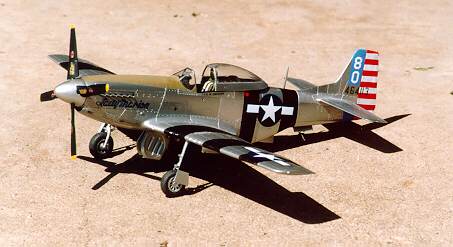
Type: P-51D
Scale: 1/48
Price: US$27.00
Markings: (8th AF)4 aircraft: "Petie 2nd", Col. John C. Meyer, 487FS, 357FG; "Nooky Booky IV", Maj. "Kit" Carson, 362FS, 357FG; "Lou IV", Thomas J. Christain, 375FS, 361FG; unnamed, Urban L. Drew, 375FS, 361FG.

One could hear the groans across the collective model world when this kit was announced. "Not another P-51D!" "Thirty-six bucks for a 1/48 WWII fighter?" Then the kit arrived, and the groans changed to contentment, and even acclaim, for, at last, a definitive P-51D kit has finally been produced in 1/48th. Tamiya even sweetened the bait by lowering the retail price from $36.00 to $27.00, and judicious shopping can even yield kits at $18.00 with some effort.
The kit features finely recessed panel lines, with judicious use of raised rivets where appropriate. Conponent fit of the major parts is unbelievably good; most parts breakdowns are along panel lines on the actual aircraft, and joints look exactly like the engraved panel lines elsewhere on the kit! The wing-to-fuselage joint, a sore point on other kits, took me all of 15 minutes to bring to the perfection required for a natural metal finish! Accuracy appears to be right on as well, down to the properly offset angle of the vertical fin.
Other good points include the wheel wells, flaps, and ducting. The wheel wells are well detailed, and actually look deep enough to accept the landing gear--a feature often not seen even in the best kits. For the first time, a manufacturer has included flaps that can be positioned down--the pose most often seen in parked P-51s. As for the ducting, radiator screens can be seen when looking up the underwing radiator inlet, and down the waste gate.
Another nice bit of engineering is the propellor. The blades are cemented in after assembling the spinner halves, and are tabbed so that a uniform pitch can be achieved on each blade. The propellor has a poly cap, which secures it to the model while still allowing for easy removal should it be needed for transport or painting.
Cockpit detail is good, not great. I added a few brass goodies to my cockpit and it came out looking nice. Other modelers might want to consider the resin cockpit sets available for this kit. That said, the stock cockpit is adequate for the scale.
The clear parts are well formed, but the sprue gates go right into the sides of the canopy, and removing the parts without putting permanent mars into the clear is difficult. I found that the best way to address it is to cut the canopies out well away from the surface, and gently sand and polish the nubs down until it is level with the canopy. It is tricky, but it works.Both standard and Dallas-type canopies are provided, so you might try it out on the canopy you don't plan on using first. An alternative might be to try the vacuform canopies that Squadron sells; I haven't tried this myself.
The decals in the first issues of this kit are Tamiya manufactured, and while well printed, they are thick. Then again, you've seen these guys before on after market sheets, so if you want them, use those! I finished mine from Aeromaster sheet 48-12 for a 5th AF aircraft.
Depending on what era and theatre you want to model, it is worth considering the F-51D issue of this kit. The 8th AF kit reviewed here has 2 75G drop tanks for underwing stores. The F-51D has 2 500# bombs, and stub racks for underwing HVARs (and the HVARs, also). If you're doing a late-war PTO aircraft, especially those based on Iwo Jima, the F-51D is the one to use as P-51Ds there often were delivered with HVAR stubs in place. If you're staying in the ETO, get friendly with a guy owning a Tamiya P-51B and see if he'll trade you the tanks from that kit, which are the 110G "paper" tanks favored late in the European war.
This kit is so well engineered, a trained chimpanzee could produce a good replica! If you are planning your umpteenth P-51D (like Scotty is planning his umpteenth F-4!) the Tamiya kit is the kit of choice.